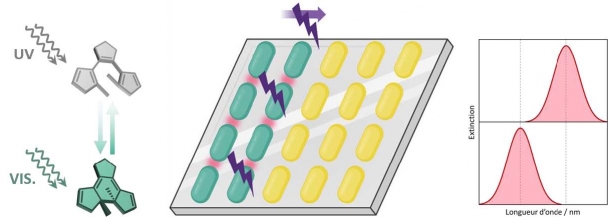Title:
Resume:
New hybrid systems involving metallic nanoparticles and organic molecules are a prime matter of interest because of their new properties coming from the synergy between the hybrid building blocks. Many fields can take advantage of them: imaging, electronics, coating detection in biological systems. The key points of such devices are understanding the properties at the nanometric scale and upscaling them to the macroscopic scale.
This PhD work rely on the use of gold nanorods and photochromic compounds, more precisely diarylethenes. Gold nanorods exhibit unique enhancement ability thanks to surface plasmon, while diarylethenes are reversible molecular photo-switches (photo-conversion between two isomers having different optical properties).
We developed and studied in solution hybrid reversible photo-switchable materials combining a gold nanorod and several molecules of diarylethenes, grafted to the surface thanks to a process based on electrostatic interactions. The molecules we use are charged and we characterized them by steady-state and time-resolved spectroscopies, supported by TD-DFT calculations. Both nanoparticles’ (plasmon resonance) and molecules’ (photo-conversion dynamics) properties change as a result of their mutual interactions inside the hybrid material.
In order to transpose these properties to the macroscopic scale, we developed a new method combining deep-UV lithography and specific nanoparticle functionalization. Hence we got large-scale organized gold nanorods self-assemblies showing huge plasmonic coupling and studied them by photo-emission electron microscopy to characterize their local field and the plasmonic couplings (position and intensity).
Such autonomous devices are very promising because triggered by light, one of the most eco-responsible stimulus. Mastering the upscaling of specific properties from nanoscopic to macroscopic scale opens new ways in molecular opto-electronics, medical imaging and adaptative autonomous materials.
This work is available online.

